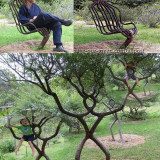Welwitschia
Welwitschia
Welwitschia mirabilis is a perennial plant that grows up to 2 metres high. It has a taproot that is elongated, usually branching near the apex. Welwitschia is named after the Austrian botanist Friedrich Welwitsch who discovered it in 1859.
The woody, unbranched stem often splits into 2 lobes with an obconical shape – a conical shape but with a downwards-pointing apex. The apex growth of the stem stops at an early stage giving this peculiar and unique habit.
It is a dioecious plant, so male and female cones are produced on separate plants:
- Salmon-coloured male strobili are oblong, cone-like structures that are 1–4cm long, 5–7mm wide, and on a pedicel 2–5 mm long, with bracteoles1–3mm long.
- Female strobili are larger than male strobili – 3.5–8cm long, 2–3cm wide, with outer bracteoles 5mm long and inner bracteoles 8mm long. The age of the plants is difficult to assess, but they are very long-lived, living 1000 years or more. Some individuals may be more than 2000 years old.











